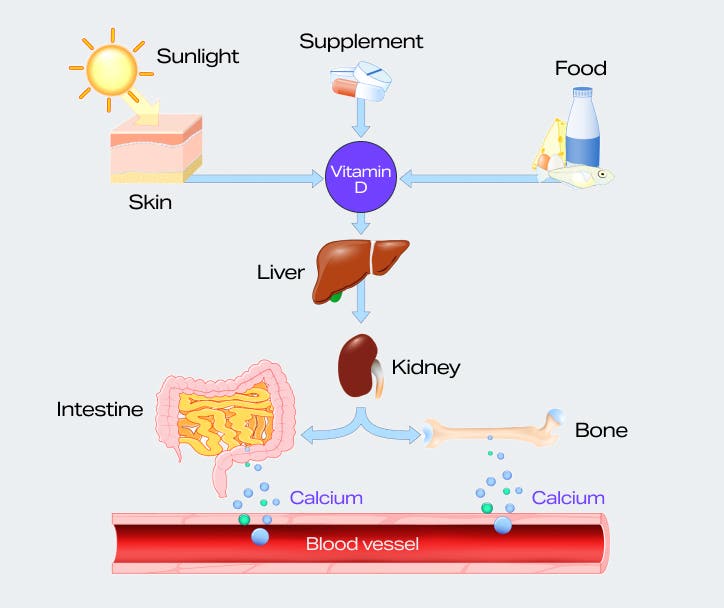As an athlete, you're always seeking ways to boost performance. While fine-tuning your training and nutrition take priority, don't overlook the game-changing power of vitamin D.
That's right – we’re talking about the sunshine vitamin. Vitamin D's superpowers impact both our health and performance. Let's dive into why this solar nutrient matters and how to ensure you get enough.
What’s the deal with vitamin D?
It gets plenty of buzz, but what's the real deal with vitamin D? Here's the scoop: vitamin D is a fat-soluble vitamin. These vitamins dissolve in fat and stick around in your body for a long time. However, vitamin D is actually a steroid hormone your body produces from cholesterol when exposed to sunlight, earning it the nickname “the sunshine vitamin.”
You can get vitamin D from food or supplements, but the most accessible vitamin D source is sunlight. UVB rays from the sun initiate vitamin D production in the skin. A type of cholesterol in the skin called 7-dehydrocholesterol absorbs the UVB radiation from the sun and converts it into vitamin D3.
In the liver, vitamin D is metabolized into the circulating form 25,-hydroxyvitamin D and converted to the active form 1,25-dihydroxyvitamin D in the kidneys. The latter is important for skeletal health.8

Several factors can make it difficult to get your daily dose of vitamin D, especially in regions where consistent sunshine is scarce, reducing the amount of vitamin D your skin produces. But don’t worry – you can also get vitamin D from your diet; you just need to know which foods to reach for.
There are two types of dietary vitamin D:
- Vitamin D3 or cholecalciferol: Found in some animal products like egg yolks and oily fish.
- Vitamin D2 or ergocalciferol: Present in some plant foods like mushrooms.1
There is evidence that vitamin D3 has a greater effect on vitamin D levels than vitamin D2, which could influence the type of supplement you use if you need it.2
The importance of vitamin D for athletes
Vitamin D is a key player in our overall health, especially concerning bone and muscle health, making it essential for peak athletic performance.
Bone health
Vitamin D is responsible for aiding calcium absorption in the small intestine. Without an adequate amount of vitamin D, the body absorbs less than 15% of dietary calcium, which can have a detrimental effect on bone health. On the flip side, when you nail your vitamin D levels (with the right amount), calcium absorption increases to 30 to 40%, ensuring your bones are healthy and strong.3
Muscle health
Your muscles rely on vitamin D for strength and performance. Studies have found that vitamin D supplementation positively influences muscle strength, while deficiency causes weakness.4
Immunity
Although the role of vitamin D is widely recognized, its impact on immune health is just as important. Vitamin D helps to regulate the immune system and deficiency has been linked to an increased risk of developing autoimmune conditions and an increased susceptibility to infection.5
Anti-inflammation
Vitamin D has potent anti-inflammatory properties, helping to reduce pro-inflammatory cytokines and increasing their anti-inflammatory counterparts.6 Research studies have demonstrated that improving vitamin D levels can reduce chronic inflammation in deficient people.7

Sources of vitamin D
Vitamin D can be acquired from three main sources:
- Sunlight
- Food
- Supplements
Sunlight
Sunlight exposure is the most natural way to boost your vitamin D levels. However, certain factors can influence how much vitamin D you get from the sun, including:
- Age - as we get older, the amount of vitamin D-producing 7-dehydrocholesterol in the skin decreases.
- Geographic location - the closer you live to the equator, the more direct sunlight (and more UVB) you receive year-round. UVB exposure decreases the farther you are from the equator, especially in winter.
- Skin color - the melanin in our skin absorbs UVB rays. Individuals with darker skin tones require more sun exposure to produce the same amount of vitamin D compared to those with lighter skin.
- Time of year - the sun’s angle and UVB intensity vary with the seasons. During winter, the sun is lower in the sky resulting in less UVB reaching the earth’s surface.
- Sunscreen use - sunscreen blocks UVB rays, reducing vitamin D synthesis. While sunscreen is important to protect against skin cancer, limited unprotected sun exposure can help maintain vitamin D levels.
- Exposure to the outdoors - spending more time outdoors generally leads to increased sun exposure, which in turn boosts vitamin D synthesis.
If you can get outside, exposing your skin for 10 to 30 minutes several times per week, particularly during the summer, can help top up your vitamin D levels.
What foods have vitamin D?
If your sunlight exposure simply isn’t in the cards for whatever reason, there are a few reliable vitamin D foods that you can incorporate into your meals:
- Oily fish (mackerel, salmon, sardines)
- Egg yolks
- Mushrooms
- Fortified cereals, milk, and juice
Vitamin D supplements
In some cases, you may need to turn to supplements to hit your vitamin D levels. Especially if you train indoors or live in latitudes far from the equator, supplementation is a viable option for improving your vitamin D levels and is often recommended.
In the northern latitudes, the seasons can severely affect circulating vitamin D levels.9 In the UK, for example, everyone over four years old is advised to take a daily supplement containing 10 micrograms (mcg) of vitamin D during autumn and winter.10
How do I know if I’m not getting enough vitamin D?
Alright, we've hyped up the sunshine vitamin quite a bit, but how can you tell if your levels are where they should be? The only way to confirm vitamin D deficiency is through blood testing done by a doctor or clinic.
If you are vitamin D deficient, you may experience the following symptoms:
- Muscle and bone pain
- Muscle weakness
- Fatigue
- Mood changes
- Frequent infections
- Hair loss
When can I consider taking a supplement?
Generally, the recommended daily intake of vitamin D for people aged 19 to 70 is 15 mcg or 600 IU,11 but some people may need to consider a daily supplement. They include:
- The elderly
- Athletes
- People with dark skin tones
- Anyone who lives in northern latitudes
- People who get little outdoor exposure (e.g., people in care homes or prisons)
Vitamin D myths
Now that you're in the know about vitamin D, let's debunk some of the most common myths and separate fact from fiction.
Myth 1: The more vitamin D, the better
Let's clear things up: while it's crucial to maintain adequate vitamin D levels, excessive supplementation can be toxic. Taking too much can lead to unpleasant symptoms such as illness, muscle weakness, and kidney damage. Instead, keep your vitamin D intake balanced and don’t exceed the recommended daily intake. We recommend to always consult with your doctor before taking any supplements.
Myth 2: All vitamin D supplements are created equal
The simple answer: no, they’re not. You can increase your blood vitamin D levels more effectively by taking supplements containing vitamin D3 rather than vitamin D2.
Myth 3: The sun is the end all be all for vitamin D
Although the sun is the most convenient source of vitamin D, factors like location, season, sunscreen use, and skin tone can impact its production. For athletes training indoors, relying on sunshine alone might not suffice, and you may need to turn to supplementation to ace your D levels.
Let’s recap
Vitamin D isn't just important—it's crucial for athletes, vital for bone and muscle health, and bolstering immunity. By ensuring optimal levels through sun exposure, diet, and supplements (if needed), you'll enhance performance and reduce injury risks. So solar power up your training with this sunshine nutrient and get after those goals!
Sources
[1] Chang, S.-W. and Lee, H.-C. (2019) ‘Vitamin D and health - the missing vitamin in humans’, Pediatrics & Neonatology, 60(3), pp. 237–244. doi:10.1016/j.pedneo.2019.04.007.
[2] Tripkovic, L., Lambert, H., Hart, K., Smith, C. P., Bucca, G., Penson, S., Chope, G., Hyppönen, E., Berry, J., Vieth, R., & Lanham-New, S. (2012). Comparison of vitamin D2 and vitamin D3 supplementation in raising serum 25-hydroxyvitamin D status: a systematic review and meta-analysis. The American journal of clinical nutrition, 95(6), 1357–1364. https://doi.org/10.3945/ajcn.111.031070
[3] Khazai, N., Judd, S. E., & Tangpricha, V. (2008). Calcium and vitamin D: skeletal and extraskeletal health. Current rheumatology reports, 10(2), 110–117. https://doi.org/10.1007/s11926-008-0020-y
[4] Rejnmark L. (2011). Effects of vitamin d on muscle function and performance: a review of evidence from randomized controlled trials. Therapeutic advances in chronic disease, 2(1), 25–37. https://doi.org/10.1177/2040622310381934
[5] Aranow C. (2011). Vitamin D and the immune system. Journal of investigative medicine : the official publication of the American Federation for Clinical Research, 59(6), 881–886. https://doi.org/10.2310/JIM.0b013e31821b8755
[6] Krajewska, M. et al. (2022) ‘Vitamin D effects on selected anti-inflammatory and pro-inflammatory markers of obesity-related chronic inflammation’, Frontiers in Endocrinology, 13. doi:10.3389/fendo.2022.920340.
[7] Zhou, A. and Hyppönen, E. (2022) ‘Vitamin D deficiency and C-reactive protein: A bidirectional mendelian randomization study’, International Journal of Epidemiology, 52(1), pp. 260–271. doi:10.1093/ije/dyac087.
[8] Wacker, M., & Holick, M. F. (2013). Sunlight and Vitamin D: A global perspective for health. Dermato-endocrinology, 5(1), 51–108. https://doi.org/10.4161/derm.24494
[9] Huotari, A. and Herzig, K.-H. (2008) ‘Vitamin D and living in northern latitudes—an endemic risk area for vitamin D deficiency’, International Journal of Circumpolar Health, 67(2–3), pp. 164–178. doi:10.3402/ijch.v67i2-3.18258.
[10] Vitamin D (2020) NHS choices. Available at: https://www.nhs.uk/conditions/vitamins-and-minerals/vitamin-d/ (Accessed: 11 June 2024).
[11] Office of dietary supplements - vitamin D (2023) NIH Office of Dietary Supplements. Available at: https://ods.od.nih.gov/factsheets/VitaminD-HealthProfessional/#h3 (Accessed: 11 June 2024).